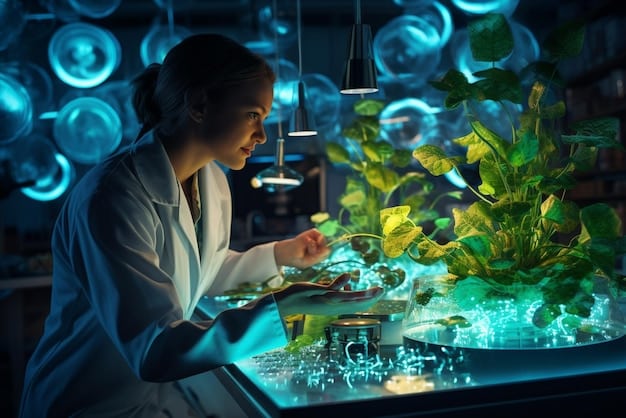Synthetic Biology: New Materials & Applications by 2027

Synthetic biology is poised to revolutionize material science and various applications by 2027, offering bio-designed materials with enhanced functionalities, sustainable production methods, and a wide range of innovations across industries like medicine, manufacturing, and environmental conservation.
Get ready to explore the transformative potential of synthetic biology: What new materials and applications can we expect by 2027? This field is rapidly evolving, promising groundbreaking advancements in how we design and produce materials for a sustainable future.
Synthetic Biology: A Primer
Synthetic Biology is an interdisciplinary branch of biology and engineering. This area combines genetic engineering with engineering principles to design and construct biological systems that exhibit novel functions. The field holds the promise of creating innovative solutions for many challenges in medicine, materials science and environmental protection.
The Core Principles of Synthetic Biology
At its core, synthetic biology is about making biology easier to engineer. It involves standardization of biological parts, modular design and abstraction to create complex systems from simpler, well-defined parts. This approach enables scientists to predictably and efficiently build new biological functions.
Key Techniques Used in Synthetic Biology
- DNA Synthesis: Chemically synthesizing DNA sequences to encode for specific functions.
- Genetic Engineering: Modifying the genetic material of organisms to introduce new traits.
- Metabolic Engineering: Optimizing metabolic pathways in cells to produce desired compounds.
- BioBricks: Standardized biological parts that can be easily assembled to create complex systems.
The potential of synthetic biology stretches far beyond the lab, promising to reshape industries and our interactions with nature. To truly appreciate its impact, let’s delve into some of the major achievements that have set the stage for the innovations arriving in the near future.

Major Achievements in the Field
Synthetic biology has already delivered significant achievements. These successes, which span from biomedical applications to novel materials, have been fundamental in establishing the field’s potential for real-world impact.
Engineering Microorganisms for Drug Production
One of the earliest and most impactful achievements in synthetic biology has been the engineering of microorganisms to produce valuable drugs. For example, scientists have successfully engineered yeast to produce artemisinin, a critical antimalarial drug. This achievement has streamlined drug production, reducing costs and increasing accessibility.
Creating Biosensors for Environmental Monitoring
Synthetic biology has also played a vital role in creating biosensors for environmental monitoring. These sensors use engineered biological systems to detect pollutants or other environmental hazards. They offer a faster, more accurate and cost-effective way to assess the health of our planet.
- Detection of Arsenic: Engineered bacteria can detect arsenic in drinking water providing an early warning system for contaminated water sources.
- Monitoring Air Quality: Biosensors for volatile organic compounds (VOCs) can monitor air quality in urban and industrial environments.
- Soil Health Assessment: Engineered microbes can assess soil health by detecting specific biomarkers.
Major achievements like these highlight the transformative power of synthetic biology. These accomplishments pave the way for even more groundbreaking innovations in the coming years. With a solid foundation of success, the field is set to produce exciting new materials and applications.
Novel Materials on the Horizon
In the realm of materials science, synthetic biology promises to deliver unprecedented advancements. By harnessing the power of biological systems, scientists are engineering novel materials with unique properties and functionalities.
Self-Healing Materials
Self-healing materials represent a significant innovation in materials science. These materials can automatically repair damage. Synthetic biology facilitates this through incorporating biological components. Engineered bacteria can produce biopolymers that fill cracks and mend structural damage on their own, thereby extending the lifespan and durability of products.
Living Materials
Living materials combine living cells with non-living components to create functional composites. These materials can respond to environmental stimuli, self-replicate or even perform complex tasks such as cleaning up pollutants. They are used in construction, environmental remediation and biomedical engineering.
- Self-Repairing Concrete: Bacterial spores embedded in concrete can germinate to repair cracks and prevent structural failure.
- Air-Purifying Walls: Algae-based living walls capture and metabolize air pollutants improving indoor air quality.
- Adaptive Textiles: Fabrics embedded with responsive cells that can adjust to temperature and humidity for enhanced comfort.
These innovations show the incredible versatility of synthetic biology. As the field advances, the development of advanced biologically created materials will continue to surge, reshaping traditional industries and introducing sustainable, high-performance solutions for a range of applications.
Medical Applications
The medical field stands to gain significantly from synthetic biology. Advances in this area could lead to revolutionary diagnostic tools, personalized therapies and innovative drug delivery systems.
Personalized Medicine
Synthetic biology enables the development of personalized treatments tailored to an individual’s specific genetic makeup. Engineered cells act as diagnostic tools and therapeutic agents, targeting specific diseases with greater precision, resulting in more successful outcomes.
Advanced Diagnostics
Improved diagnostics are being developed through synthetic biology. Biosensors can identify disease biomarkers earlier and more accurately than traditional methods. These advanced diagnostic tools will result in earlier intervention and care.
- Cancer Detection: Engineered immune cells can detect and target cancer cells with higher accuracy.
- Rapid Pathogen Identification: Synthetic biology-based sensors can quickly identify pathogenic infections, helping with the rapid deployment of treatments.
- Monitoring Chronic Diseases: Wearable biosensors can monitor glucose levels in diabetes patients for better management.

Synthetic biology’s potential to revolutionize medical practice will continue expanding with further innovations. Better diagnostics and treatments could significantly improve global healthcare outcomes.
Environmental and Industrial Applications
Synthetic biology offers promising solutions for sustainability in the environmental and industrial sectors. By genetically modifying biological systems, synthetic biology improves efficiency, reduces pollution and fosters sustainability. This will change environmental and industrial practices.
Bioremediation
Bioremediation involves using biological systems to remove pollutants. Synthetic microorganisms can break down toxins or recover valuable resources from waste, offering an efficient solution to environmental cleanup.
Sustainable Manufacturing
The techniques of synthetic biology can make manufacturing more sustainable. By engineering microorganisms to create biofuels, bioplastics and other valuable bioproducts, synthetic biology reduces dependence on fossil fuels and minimizes environmental footprint.
- Bioplastics: Engineered bacteria produce biodegradable plastics to reduce plastic waste.
- Biofuels: Algae and bacteria are optimized to produce biofuels, decreasing reliance on petroleum.
- Sustainable Chemicals: Microbial processes produce bio-based chemicals, which can lessen the environmental impact of chemical manufacturing.
The impact of synthetic biology in environmental protection is substantial. The field will accelerate the adoption of green technologies and encourage the development of a circular and sustainable economy through advances in these and other applications.
Challenges and Future Directions
Despite its potential, synthetic biology faces ethical, safety and technological challenges. Scientists and policymakers need to overcome these challenges to effectively harness the power of synthetic biology.
Ethical Concerns
Ethical issues such as unintended consequences, biosecurity risks and equitable access to technologies are potential obstacles to the advancement of synthetic biology. These challenges need to be thoughtfully addressed.
Safety and Regulations
Ensuring the safety of engineered organisms requires robust regulatory frameworks. Governments must establish guidelines for the development, use and release of synthetic biological agents. This protects the public and the environment.
Technological Bottlenecks
Overcoming current technical bottlenecks, such as improving the predictability and scalability of engineered biological systems, is important to the development of synthetic biology. More robust technologies can lead to the faster creation of a lot more practical applications.
Synthetic biology is now in a stage of rapid development, and the ability to address these concerns will determine its long-term success. Continued research and innovation, combined with ethical insight and responsible policy, will unlock the full potential of synthetic biology and ensure that its benefits are wide and lasting.
| Key Point | Brief Description |
|---|---|
| 🧬 Novel Materials | Self-healing and living materials lead to advanced applications. |
| 💊 Medical Advances | Personalized medicine and improved diagnostics target diseases. |
| 🌱 Environmental Benefits | Bioremediation and sustainable manufacturing reduce pollution. |
| 🛡️ Challenges Ahead | Ethical, safety, and technological hurdles need addressing. |
Frequently Asked Questions
▼
Synthetic biology is a field that combines biology and engineering to design and construct new biological systems or modify existing ones for useful purposes. It aims to make biology easier to engineer.
▼
Applications include creating new materials, producing pharmaceuticals, developing biosensors, and bioremediation. It can also be used for sustainable manufacturing and personalized medicine.
▼
Ethical concerns include potential unintended consequences, biosecurity risks, and equitable access to technologies. There are also broad environmental and health concerns that require discussion and solutions.
▼
Biosensors use engineered biological systems to detect pollutants or other hazards. These sensors provide quicker, easier, and more accurate environmental health assessments.
▼
The future involves overcoming technological and ethical hurdles to unlock its potential. Continued efforts in research, along with responsible policy, should lead to expansive, beneficial applications.
Conclusion
The rise of synthetic biology: What new materials and applications can we expect by 2027? points to a world transformed by bio-designed solutions. From self-healing materials to personalized medicine, this field promises to revolutionize industries and address global challenges. By continuing to innovate and address ethical concerns, the potential of synthetic biology can be fully realized, ensuring a sustainable and technologically superior future.





